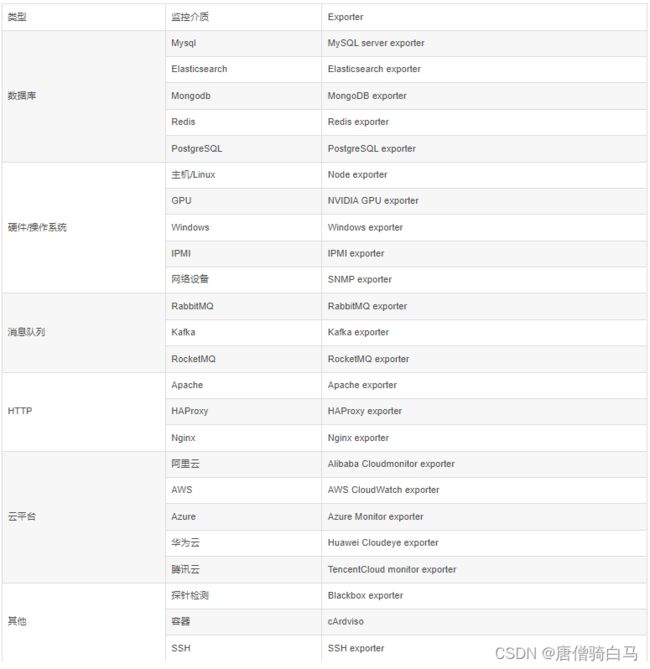Prometheus监控实战系列十五:Exporter详解
从广义的层面上讲,任何遵循Prometheus数据格式 ,可对其提供监控指标的程序都可以称为Exporter。在Prometheus社区中提供了丰富多样的Exporter供选择,如前面用到的node_exporter。
这些Exporter不仅类型丰富,功能上也很强大,通过合理的使用可以极大的方便我们的运维监控工作。除此之外,Prometheus还提供了支持多种开发语言的Clinet Libraries,用于满足Exporter的定制化开发需求。
本文将对Exporter进行介绍,包括工作中常用到的Exporter,以及如何通过Clinet Libraries开发自定义的Exporter。
1、Exporter运行方式
1.1 独立运行
以前面使用过的node_exporter为例,由于操作系统本身并不直接支持Prometheus,因此,只能通过一个独立运行的程序,从操作系统提供的相关接口将系统的状态参数转换为可供Prometheus读取的监控指标。
除了操作系统外,如Mysql、kafka、Redis等介质,都是通过这种方式实现的。这类Exporter承担了一个中间代理的角色。
2.2 应用集成
由于Prometheus项目的火热,目前有部分开源产品直接在代码层面使用Prometheus的Client Library,提供了在监控上的直接支持,如kubernetes、ETCD等产品。
这类产品自身提供对应的metrics接口,Prometheus可通过接口直接获取相关的系统指标数据。这种方式打破了监控的界限,应用程序本身做为一个Exporter提供功能。
2、常用的Exporter
下面表格是一些较常使用到的Exporter,内容覆盖了数据库、主机、HTTP、云平台等多个层面。

除以上这些外,还有很多其他用途的Exporter,有兴趣的朋友可以自行查看官网:https://prometheus.io/docs/instrumenting/exporters/。
3、自定义Exporter
虽然Promethesu社区提供了丰富多样的Exporter给用户使用,但由于各家公司的环境都有自身的特点,有时候可能无法在现有资源中找到合适的工具。对此,我们可以利用Prometheus的Clinet Libraries,开发符合实际需要的自定义Exporter。
Clinet Libraries支持的语言版本非常丰富,除了官方提供了Go、Java or Scala、Python和Ruby几种外,还有很多第三方开发的其他语言版本。
本文我们将以Python为例,演示Exporter的开发。
示例:开发一个exporter,并用于获取系统网络连数状态为TIME_WAIT的数量指标。
本次将调用到的Linux的命令如下 ,用于获取系统的TIME_WAIT连接数量
yum install epel-release
yum install -y python-pip
使用pip安装python的prometheus-client库
pip install prometheus-client
在Python开发中引入prometheus-client和commands库,command库用于执行Linux系统命令。
from prometheus_client import Gauge
import commands
定义一个Gauge指标,名称为time_wait_count,并添加标签type。
time_wait_count = Gauge('time_wait_count', 'time_wait count of system',['type'])
定义执行函数,函数调用上面的Linux命令,用于获取相关的指标信息
def get_time_wait_count():
number=commands.getoutput('netstat -an |grep TIME_WAIT |wc -l')
time_wait_count.labels('Linux').set(int(number))
现在,我们可以通过执行get_time_wait_count函数获取到time_wait_count的指标value,但要做为一个exporter运行,我们还得支持http协议。
此处,可以用到prometheus_client的start_http_server模块,该模块支持做为http服务启动。
完整的代码如下:
[root@server ~]# cat mytest_exporter.py
from prometheus_client import start_http_server, Gauge
import os
time_wait_count = Gauge('time_wait_count', 'time_wait count of system', ['type'])
def get_time_wait_count():
command = "netstat -an |grep TIME_WAIT |wc -l"
number = os.system(command)
# number = commands.getoutput('netstat -an |grep TIME_WAIT |wc -l')
time_wait_count.labels('Linux').set(int(number))
if __name__ == '__main__':
# Start up the server to expose the metrics.
start_http_server(8090)
# Generate some requests.
while True:
get_time_wait_count()
将代码保存为mytest_exporter.py,在需要监控的服务器上运行该程序(需要python3)
python3 mytest_exporter.py
访问http://IP:8090/metrics,可看到该Exporter已经获取到系统的相关指标
上一篇:Prometheus监控实战系列十四:Pushgateway
下一篇:Prometheus监控实战系列十六:Docker容器监控
